IoT-Based Hybrid Renewable Energy System for Smart Campus
Abstract
:1. Introduction
2. Related Work
- Propose an IoT-based architecture to support the grid integration of a hybrid renewable energy system.
- Propose a network model for the hybrid renewable energy system components, including wind turbine, PV system, energy storage, and diesel generator based on IEC 61850 standard.
- The proposed network models include different data types such as analogue measurement, status information, and control information.
- Performance evaluation of HRES with respect to network latency. A university campus in Saudi Arabia is considered as a case study.
3. IoT-Based Architecture for Hybrid Renewable Energy System
3.1. Power Layer
3.2. Data Acquisition Layer
3.3. Communication Network Layer
3.4. Application Layer
4. Modeling of Hybrid Renewable Energy System
5. Simulation Results
5.1. Building Area Network Results
5.2. Campus Area Network Results
- This paper proposed a framework for IoT-based architecture for a hybrid energy system, which consists of four main layers: namely the power, the data acquisition, the communication network, and the application layers.
- The framework studied the communication network associated with the grid integration of a hybrid energy system in a university campus consists of a small-scale wind turbine, PV system, diesel generator, and battery storage system.
- The monitoring system has been defined based on the IEC 61850 standard, which consists of sensor nodes, data acquisition units, local control units, and a control center.
- The OPNET Modeler has been used for network modeling and simulation of the developed communication network models.
- The performance of the communication network model depends on different parameters such as the number of sensor nodes and measuring devices, number of given channels, data size, and sampling rate.
- The simulation results showed the feasibility of Ethernet-based and Wi-Fi-based architectures for control and monitoring HRES.
6. Conclusions
Author Contributions
Funding
Institutional Review Board Statement
Informed Consent Statement
Data Availability Statement
Conflicts of Interest
Abbreviations
| IoT | Internet of Things |
| HRES | Hybrid Renewable Energy System |
| IEC | International Electrotechnical Commission |
| ICT | Information and Communication Technologies |
| DER | Distributed Energy Resources |
| EMA | Energy Management Agent |
| SCADA | Supervisory Control and Data Acquisition |
| PLC | Programmable Logic Control |
| PV | Photovoltaic |
| PSO | Particle Swarm Optimization |
| BA | Bat Algorithm |
| WT | Wind Turbine |
| FC | Fuel Cell |
| BSS | Battery Storage System |
| HVAC | Heating, Ventilation and Air Condition |
| LoRa | Long Range |
| NB-IoT | Narrow Band IoT |
| HAN | Home Area Network |
| BAN | Building Area Network |
| NAN | Neighborhood Area Network |
| WAN | Wide Area Network |
| PLC | Power Line communication |
| IED | Intelligent Electronic Device |
| RTU | Remote Terminal Unit |
| HMI | Human Machine Interface |
| LAN | Local Area Network |
| EMS | Energy Management System |
| DG | diesel Generator |
| MCC | Microgrid Control Center |
| SD | Sensing Devices |
| CAN | Campus Area Network |
| BEMS | Building Energy Management System |
| CCC | Central Control Center |
| CB | Circuit Breaker |
| MU | Merging Unit |
| P&C | Protection and Control |
| LC | Local Controller |
| LCC | Local Control Center |
| GC | Generation Control |
| ESS | Energy Storage System |
| FTP | File Transfer Protocol |
References
- Kabalci, Y.; Kabalci, E.; Padmanaban, S.; Holm-Nielsen, J.B.; Blaabjerg, F. Internet of Things Applications as Energy Internet in Smart Grids and Smart Environments. Electronics 2019, 8, 972. [Google Scholar] [CrossRef] [Green Version]
- Viswanath, S.K.; Yuen, C.; Tushar, W.; Li, W.-T.; Wen, C.-K.; Hu, K.; Chen, C.; Liu, X. System design of the internet of things for residential smart grid. IEEE Wirel. Commun. 2016, 23, 90–98. [Google Scholar] [CrossRef] [Green Version]
- Saleem, Y.; Crespi, N.; Rehmani, M.H.; Copeland, R. Internet of Things-Aided Smart Grid: Technologies, Architectures, Applications, Prototypes, and Future Research Directions. IEEE Access 2019, 7, 62962–63003. [Google Scholar] [CrossRef]
- Otero, C.E.; Haber, R.; Peter, A.M.; Alsayyari, A.; Kostanic, I. A Wireless Sensor Networks’ Analytics System for Predicting Performance in On-Demand Deployments. IEEE Syst. J. 2014, 9, 1344–1353. [Google Scholar] [CrossRef]
- Minoli, D.; Sohraby, K.; Occhiogrosso, B. IoT Considerations, Requirements, and Architectures for Smart Buildings—Energy Optimization and Next-Generation Building Management Systems. IEEE Internet Things J. 2017, 4, 269–283. [Google Scholar] [CrossRef]
- Islam, S.M.R.; Kwak, D.; Kabir, H.; Hossain, M.; Kwak, K.-S. The Internet of Things for Health Care: A Comprehensive Survey. IEEE Access 2015, 3, 678–708. [Google Scholar] [CrossRef]
- Elijah, O.; Rahman, T.A.; Orikumhi, I.; Leow, C.Y.; Hindia, M.N. An Overview of Internet of Things (IoT) and Data Analytics in Agriculture: Benefits and Challenges. IEEE Internet Things J. 2018, 5, 3758–3773. [Google Scholar] [CrossRef]
- Santos, P.M. PortoLivingLab: An IoT-Based Sensing Platform for Smart Cities. IEEE Internet Things J. 2018, 5, 523–532. [Google Scholar] [CrossRef]
- Bouhafs, F.; Mackay, M.; Merabti, M. Links to the Future: Communication Requirements and Challenges in the Smart Grid. IEEE Power Energy Mag. 2012, 10, 24–32. [Google Scholar] [CrossRef]
- Ku, T.-Y.; Park, W.-K.; Choi, H. IoT energy management platform for microgrid. In Proceedings of the 2017 IEEE 7th International Conference on Power and Energy Systems (ICPES), Toronto, ON, Canada, 1–3 November 2017; pp. 106–110. [Google Scholar]
- Setiawan, M.A.; Shahnia, F.; Rajakaruna, S.; Ghosh, A. ZigBee-Based Communication System for Data Transfer Within Future Microgrids. IEEE Trans. Smart Grid 2015, 6, 2343–2355. [Google Scholar] [CrossRef]
- Zia, M.F.; Benbouzid, M.; Elbouchikhi, E.; Muyeen, S.M.; Techato, K.; Guerrero, J.M. Microgrid Transactive Energy: Review, Architectures, Distributed Ledger Technologies, and Market Analysis. IEEE Access 2020, 8, 19410–19432. [Google Scholar] [CrossRef]
- Choi, J.S. Energy Management Agent Frameworks: Scalable, Flexible, and Efficient Architectures for 5G Vertical Industries. IEEE Ind. Electron. Mag. 2021, 15, 62–73. [Google Scholar] [CrossRef]
- Eltamaly, A.M.; Alotaibi, M.A.; Alolah, A.I.; Ahmed, M.A. A Novel Demand Response Strategy for Sizing of Hybrid Energy System With Smart Grid Concepts. IEEE Access 2021, 9, 20277–20294. [Google Scholar] [CrossRef]
- Tazay, A.F.; Samy, M.M.; Barakat, S. A Techno-Economic Feasibility Analysis of an Autonomous Hybrid Renewable Energy Sources for University Building at Saudi Arabia. J. Electr. Eng. Technol. 2020, 15, 2519–2527. [Google Scholar] [CrossRef]
- Kermani, M.; Carnì, D.L.; Rotondo, S.; Paolillo, A.; Manzo, F.; Martirano, L. A Nearly Zero-Energy Microgrid Testbed Laboratory: Centralized Control Strategy Based on SCADA System. Energies 2020, 13, 2106. [Google Scholar] [CrossRef]
- Abidi, M.G.; Ben Smida, M.; Khalgui, M.; Li, Z.; Qu, T. Source Resizing and Improved Power Distribution for High Available Island Microgrid: A Case Study on a Tunisian Petroleum Platform. IEEE Access 2019, 7, 22856–22871. [Google Scholar] [CrossRef]
- Sawle, Y.; Jain, S.; Babu, S.; Nair, A.R.; Khan, B. Prefeasibility Economic and Sensitivity Assessment of Hybrid Renewable Energy System. IEEE Access 2021, 9, 28260–28271. [Google Scholar] [CrossRef]
- Shahraeini, M.; Javidi, H.; Ghazizadeh, M.S. Comparison Between Communication Infrastructures of Centralized and Decentralized Wide Area Measurement Systems. IEEE Trans. Smart Grid 2010, 2, 206–211. [Google Scholar] [CrossRef]
- Stefanov, A.; Liu, C.-C. ICT modeling for integrated simulation of cyber-physical power systems. In Proceedings of the 3rd IEEE PES Innovative Smart Grid Technologies Europe (ISGT Europe), Berlin, Germany, 14–17 October 2012. [Google Scholar] [CrossRef]
- Abir, S.M.A.A.; Anwar, A.; Choi, J.; Kayes, A.S.M. IoT-enabled Smart Energy Grid: Applications and Challenges. IEEE Access 2021, 9, 50961–50981. [Google Scholar] [CrossRef]
- Shakerighadi, B.; Anvari-Moghaddam, A.; Vasquez, J.C.; Guerrero, J.M. Internet of Things for Modern Energy Systems: State-of-the-Art, Challenges, and Open Issues. Energies 2018, 11, 1252. [Google Scholar] [CrossRef] [Green Version]
- Wu, Y.; Wu, Y.; Guerrero, J.M.; Vasquez, J.C.; Palacios-Garcia, E.J.; Li, J. Convergence and Interoperability for the Energy Internet: From Ubiquitous Connection to Distributed Automation. IEEE Ind. Electron. Mag. 2020, 14, 91–105. [Google Scholar] [CrossRef]
- Bhandari, B.; Lee, K.-T.; Lee, G.-Y.; Cho, Y.-M.; Ahn, S.-H. Optimization of hybrid renewable energy power systems: A review. Int. J. Precis. Eng. Manuf. Technol. 2015, 2, 99–112. [Google Scholar] [CrossRef]
- Etamaly, A.M.; Mohamed, M.A.; Alolah, A. A smart technique for optimization and simulation of hybrid photovoltaic/wind/diesel/battery energy systems. In Proceedings of the 2015 IEEE International Conference on Smart Energy Grid Engineering (SEGE), Oshawa, ON, Canada, 17–19 August 2015; pp. 1–6. [Google Scholar]
- Ali, I.; Hussain, S. Communication Design for Energy Management Automation in Microgrid. IEEE Trans. Smart Grid 2016, 9, 1. [Google Scholar] [CrossRef]
- International Electrotechnical Commission (IEC). International Standard IEC 61400-25-2: Communications for Monitoring and Control of Wind Power Plants—Information Models, 1st ed.; International Electrotechnical Commission (IEC): Geneva, Switzerland, 2006. [Google Scholar]
- Ahmed, M.A.; Eltamaly, A.M.; Alotaibi, M.A.; Alolah, A.I.; Kim, Y.-C. Wireless Network Architecture for Cyber Physical Wind Energy System. IEEE Access 2020, 8, 40180–40197. [Google Scholar] [CrossRef]
- Eltamaly, A.M.; Ahmed, M.A.; Alotaibi, M.A.; Alolah, A.I.; Kim, Y.-C. Performance of Communication Network for Monitoring Utility Scale Photovoltaic Power Plants. Energies 2020, 13, 5527. [Google Scholar] [CrossRef]
- Yu, X.; Li, W.; Maleki, A.; Rosen, M.A.; Birjandi, A.K.; Tang, L. Selection of optimal location and design of a stand-alone photovoltaic scheme using a modified hybrid methodology. Sustain. Energy Technol. Assessments 2021, 45, 101071. [Google Scholar] [CrossRef]
- Zhang, W.; Maleki, A.; Pourfayaz, F.; Shadloo, M.S. An artificial intelligence approach to optimization of an off-grid hybrid wind/hydrogen system. Int. J. Hydrogen Energy 2021, 46, 12725–12738. [Google Scholar] [CrossRef]
- International Electrotechnical Commission. IEC 61850-7-420:2009: Communication Networks and Systems for Power Utility Automation—Part 7-420: Basic Communication Structure—Distributed Energy Resources Logical Nodes; International Electrotechnical Commission: Geneva, Switzerland, 2009. [Google Scholar]
- Serban, I.; Cespedes, S.; Marinescu, C.; Azurdia-Meza, C.A.; Gomez, J.S.; Hueichapan, D.S. Communication Requirements in Microgrids: A Practical Survey. IEEE Access 2020, 8, 47694–47712. [Google Scholar] [CrossRef]
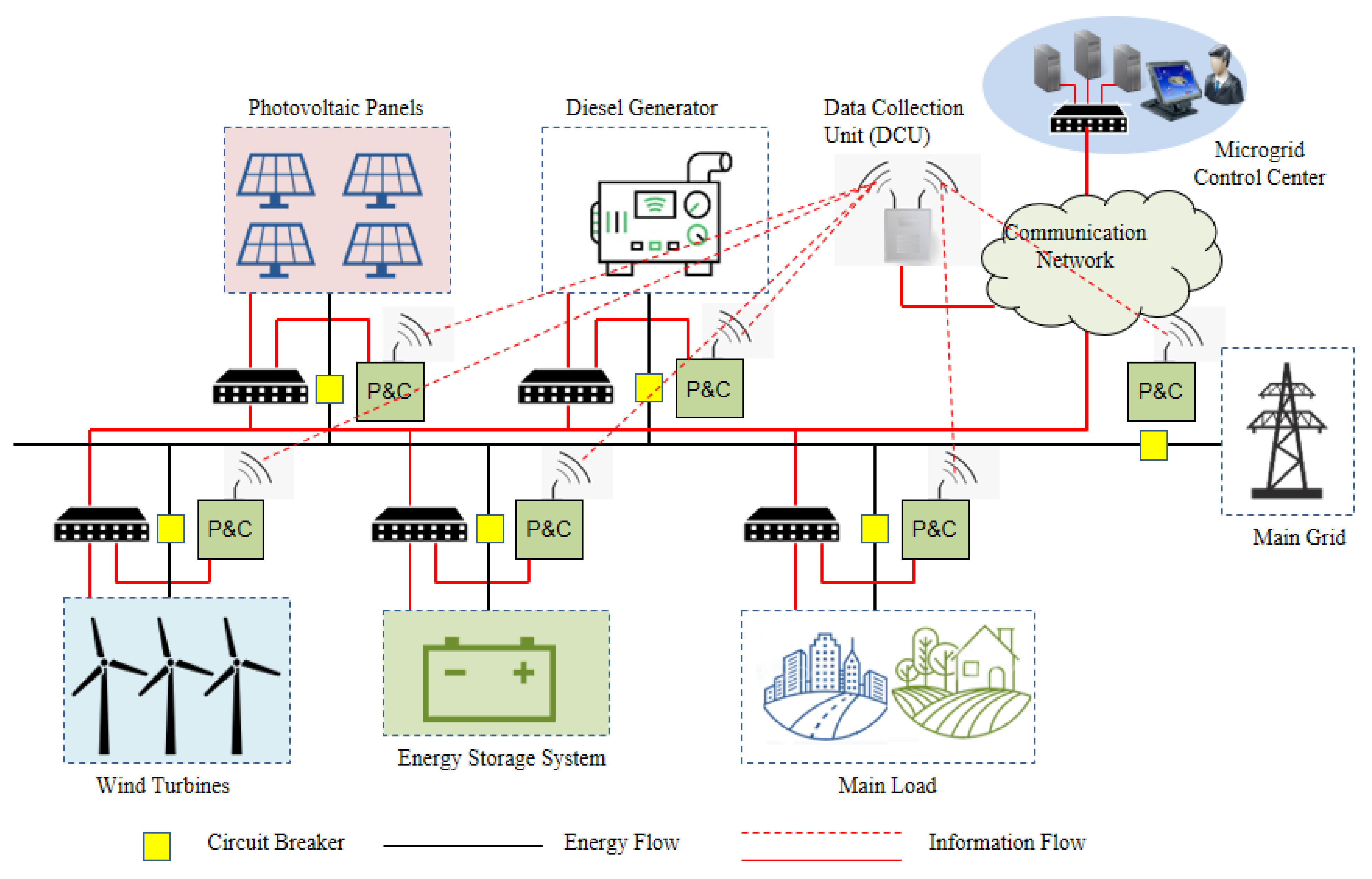
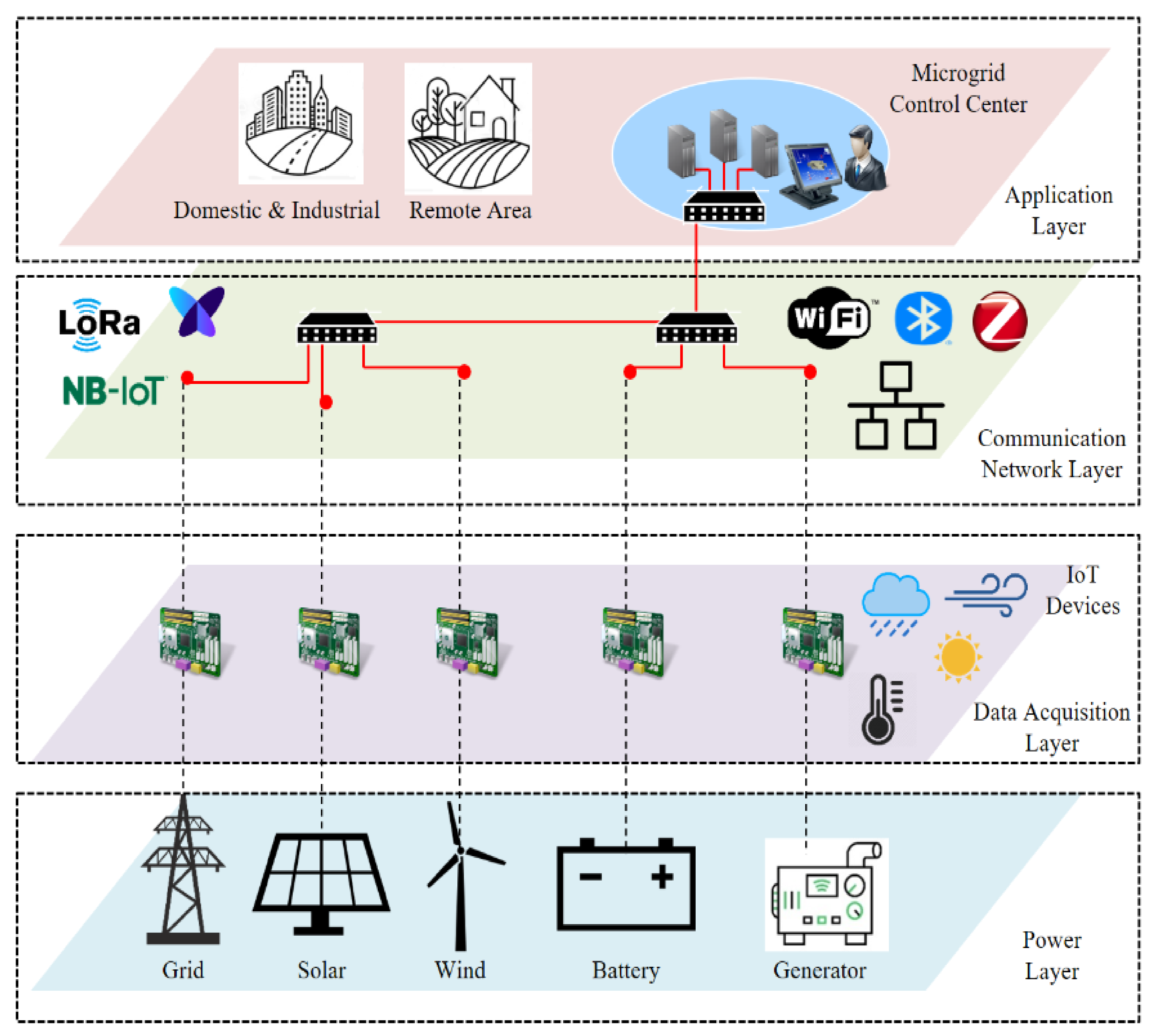
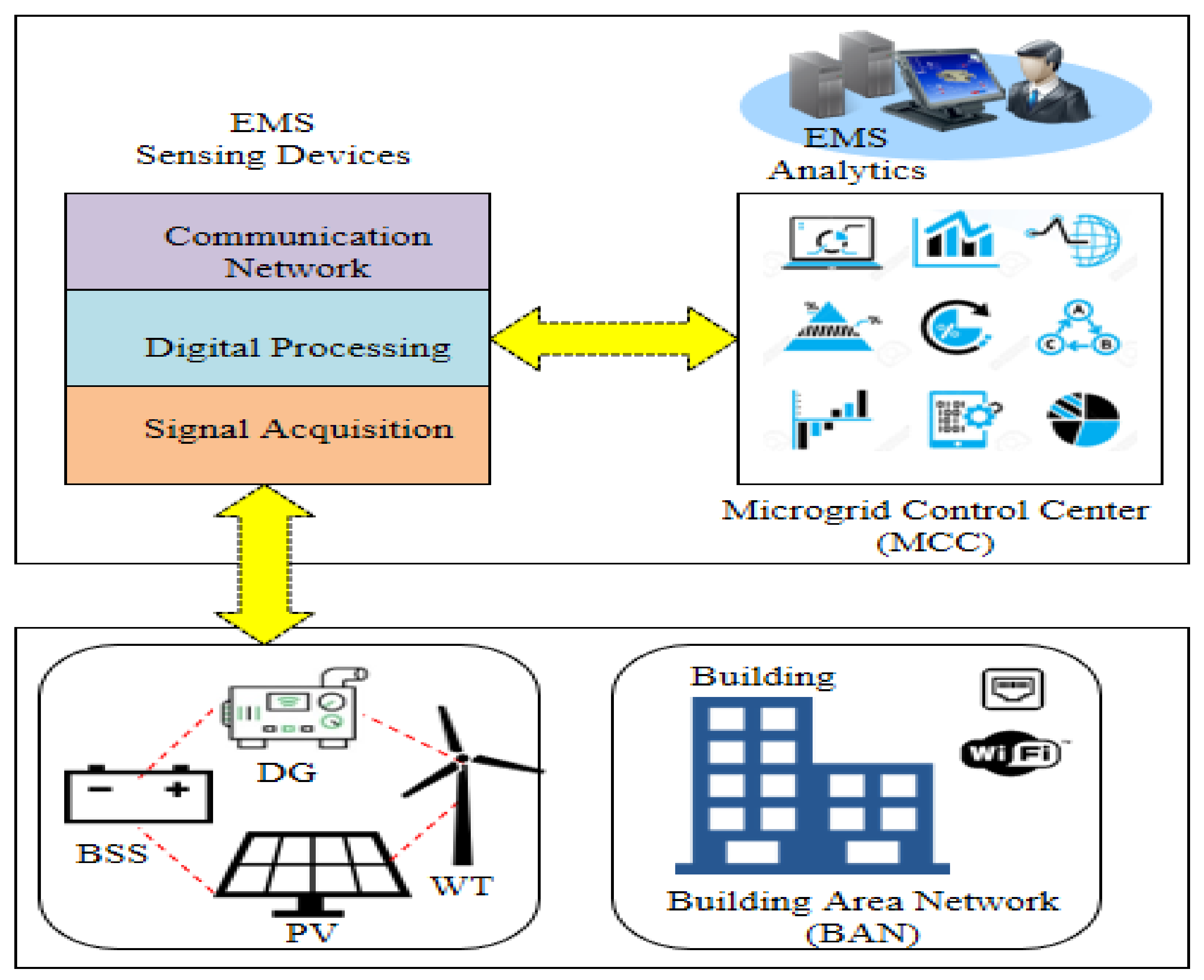

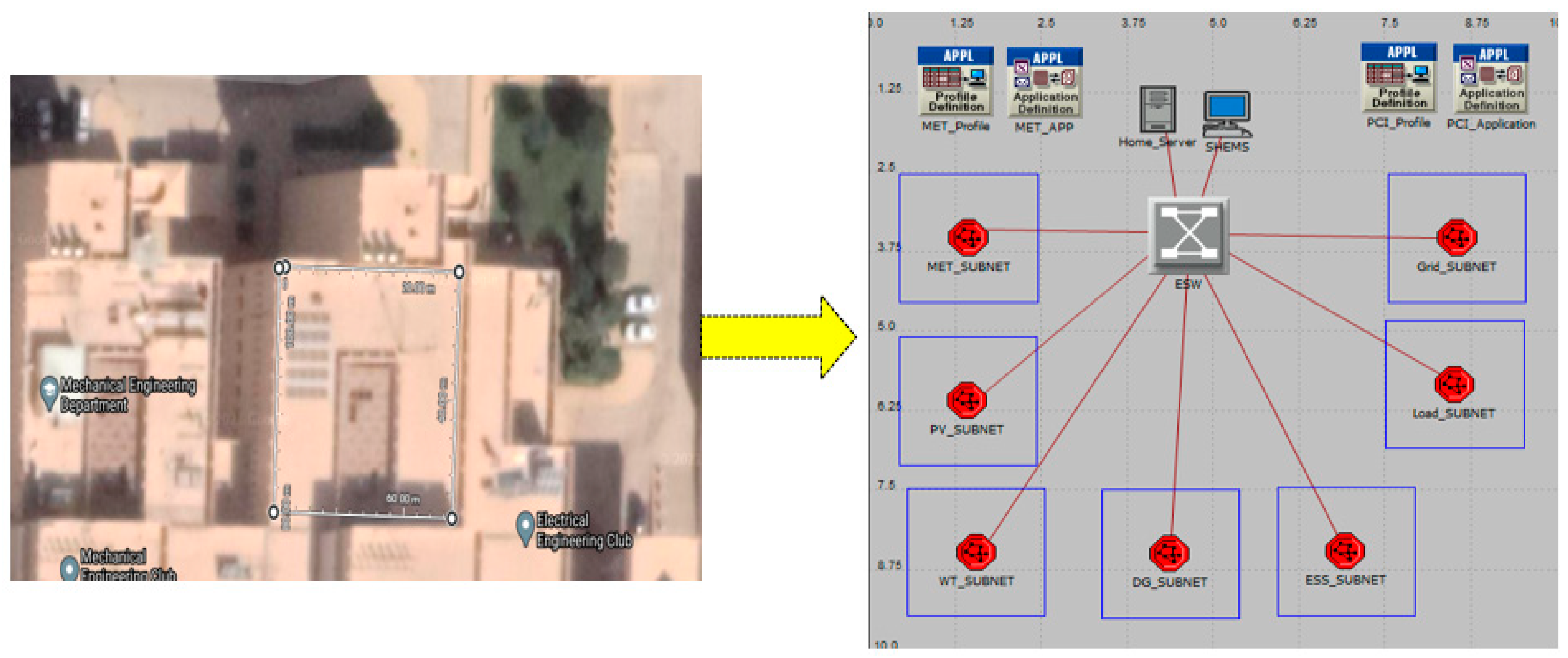
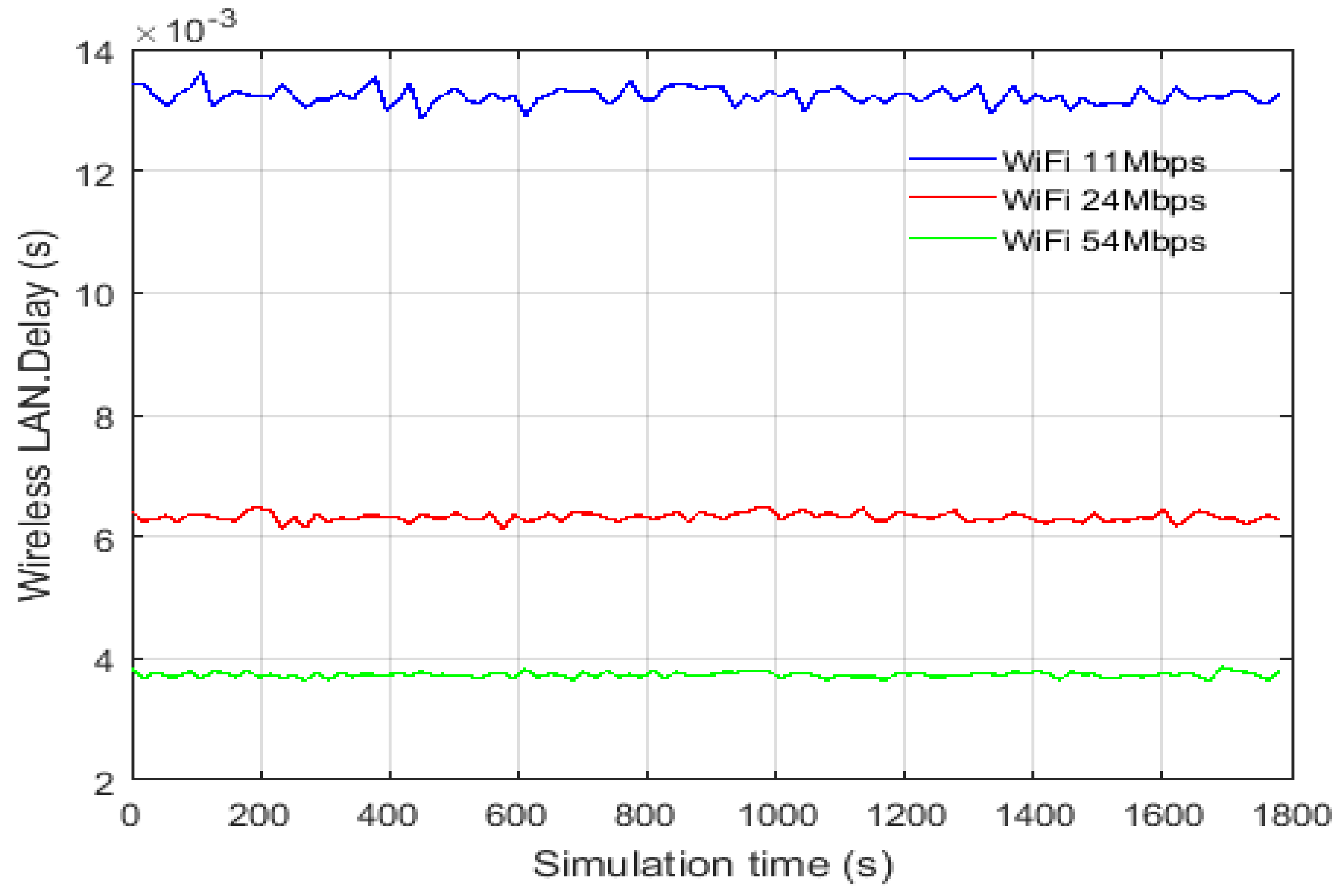



| Ref. No. | Type | Cyber-Physical Architecture Layer | Contribution | |||
|---|---|---|---|---|---|---|
| Power | Sensor | Network | Application | |||
| [1] | survey | residential | yes | yes | yes | Analyzed different IoT applications for smart grids such as smart homes, smart cities, smart meters, and management applications |
| [2] | technical | residential | yes | yes | yes | Studied a large-scale IoT system for smart homes equipped with sensors, actuators, smart meters, and smart plugs |
| [3] | survey | smart grid | yes | yes | yes | Presented a comprehensive survey on IoT-aided smart grids covering architectures, applications, and prototypes. |
| [11] | technical | microgrid | yes | yes | yes | Presented ZigBee based data communication for future microgrid applications |
| [12] | survey | microgrid | yes | yes | yes | Discussed the transactive energy concept and seven architecture layers for designing the transactive energy system |
| [21] | survey | smart grid | yes | yes | yes | Presented a survey on IoT-based smart grids, including architectures, standards, and security. |
| [22] | survey | smart grid | yes | yes | yes | Presented a general overview of IoT-based energy systems concerning key features, privacy, and challenges. |
| [23] | survey | microgrid | yes | yes | yes | Discussed the role of IoT-based microgrids, vertical convergence, energy platforms, and horizontal interoperability. |
| [14] | technical | microgrid | no | no | no | Proposed a novel demand response for sizing HRES based on techno-economic objectives using different optimization techniques |
| [15] | technical | microgrid | no | no | no | Provided a techno-economic feasibility study of HRES to support energy for a university building in Saudi Arabia |
| [17] | technical | microgrid | no | no | no | Focused on optimizing the microgrid system to achieve a balance between production sources and load requirements. |
| [18] | technical | microgrid | no | no | no | Presented a feasibility economic and sensitivity assessment of HRES for isolated urban electrification in India. |
| [24] | survey | microgrid | no | no | no | Presented a review of optimization HRES and physical modeling for wind turbines, PV systems, and engine generators. |
| [25] | technical | microgrid | no | no | no | Presented a design of a general program for sizing and optimizing a standalone hybrid wind/PV/diesel/battery system in Saudi Arabia. |
| [26] | technical | microgrid | yes | yes | yes | Presented the communication design for energy management automation in a microgrid system using Ethernet-based architecture. |
| [28] | technical | wind farm | yes | yes | yes | Presented the communication design for monitoring a wind turbine using different technologies: Ethernet, Wi-Fi, ZigBee, and WiMAX. |
| [29] | technical | PV farm | yes | yes | yes | Presented the communication design for a utility-scale photovoltaic power plant. |
| [30] | Technical | off-grid PV system | no | no | no | Presented a framework for the selection of optimal location and optimal capacity of a remote standalone PV system. |
| [31] | technical | off-grid hybrid system | no | no | no | Proposed an optimization approach for long-term capacity planning of HRES composed of wind, fuel cell, and hydrogen storage system. |
| present work | technical | microgrid | yes | yes | yes | This work proposes an IoT architecture for hybrid wind/PV/diesel/battery in a university campus. |
| Level | Coverage | Monitoring Scope | Control Decision | Technology |
|---|---|---|---|---|
| local control | LAN, BAN | HRES subsystem including solar, wind, battery, generator, grid | local | ZigBee, Wi-Fi, Ethernet, etc. |
| area control | NAN | groups of HRES | local, distributed | Wi-Fi, Ethernet, etc. |
| central control | WAN | large scale HRES | central | LoRa, NB-IoT, 4G, LTE, etc. |
| Unit | Part | Sensing Devices (SD) |
|---|---|---|
| wind turbine system | rotor | rotor speed, rotor position, pressure temperature, pitch angle, status |
| transmission | vibration, oil level, temperature, grease level, pressure, status | |
| generator | power, temperature, speed, current, voltage, status | |
| converter | current, voltage, power factor, torque, frequency, temperature, status | |
| transformer | current, voltage, oil level, temperature, status | |
| nacelle | orientation, wind Direction, wind speed, displacement, status | |
| yaw | position, speed, temperature, grease level | |
| tower | humidity, status | |
| meteorological | wind Speed, wind direction, humidity, temperature, pressure |
| Unit | Part | Sensing Devices (SD) |
|---|---|---|
| PV system | PV array | voltage, current, power, module temperature, tracker tilt angle, tracker azimuth angle |
| grid | utility voltage, current to grid, current from grid, power to grid, power from grid | |
| meteo mast | irradiance, ambient air temperature, wind speed, wind direction |
| Unit | LN | Description |
|---|---|---|
| diesel system | DGEN | status of generator |
| DEXC | status of the excitation components | |
| MPRS | pressure measurements | |
| DSFC | speed or frequency controller |
| Unit | LN | Description |
|---|---|---|
| battery system | ZBAT | remote monitoring & control of battery system |
| ZBTC | remote monitoring & control of battery charger | |
| ZRCT | characteristics of the rectifier |
| Data Type | IEC 61850 | ETSI SG Protocol |
|---|---|---|
| protection | 4 ms | 1–10 ms |
| monitoring | 1 s | 1 s |
| control | 16–100 ms | 100 ms |
| operation & maintenance | 1 s | Not specified |
| Measurement | Sampling Frequency | Number of Channels | Data Rate |
|---|---|---|---|
| ambient temperature | 1 Hz | 1 | 2 bytes/s |
| irradiance | 100 Hz | 1 | 200 bytes/s |
| wind speed | 3 Hz | 1 | 6 bytes/s |
| wind direction | 3 Hz | 1 | 6 bytes/s |
| Components | CB-IED | MU-IED | P&C IED |
|---|---|---|---|
| PV system | 1 | 1 | 1 |
| wind energy system | 1 | 1 | 1 |
| energy storage system | 1 | 1 | 1 |
| diesel generator | 1 | 1 | 1 |
| load | 1 | 1 | 1 |
| Level | Scope | Connectivity |
|---|---|---|
| load controller | monitoring and control load | LC→LCC |
| protection IEDs | control & protection | IED→LCC |
| generation control | control output | GC→LCC |
| storage control | control charge/discharge | ESS→LCC |
| load controller | monitoring and control load | LC→LCC |
| IED Type | Data Type | Data Size |
|---|---|---|
| CB IED | breaker status | 16 bytes |
| MU IED | voltage and current | 76,800 bytes |
| P&C IED | control | 76,816 bytes |
| Channel Capacity | Ethernet 10 Mbps | Ethernet 100 Mbps | Ethernet 1000 Mbps |
|---|---|---|---|
| one building | 19.44 | 1.92 | 0.19 |
| Channel Capacity | Wi-Fi 11 Mbps | Wi-Fi 24 Mbps | Wi-Fi 54 Mbps | |||
|---|---|---|---|---|---|---|
| Min | Max | Min | Max | Min | Max | |
| one building | 12.85 | 13.62 | 6.12 | 6.48 | 3.63 | 3.86 |
| Scenario | Ethernet 10 Mbps | Ethernet 100 Mbps | Ethernet 1000 Mbps |
|---|---|---|---|
| 1 building | 19.73 ms | 1.91 ms | 0.19 ms |
| 2 buildings | 39.36 ms | 3.83 ms | 0.39 ms |
| 3 buildings | -- | 5.82 ms | 0.58 ms |
| 4 buildings | -- | 7.78 ms | 0.78 ms |
| 5 buildings | -- | 9.71 ms | 0.98 ms |
| 6 buildings | -- | 11.83 ms | 1.17 ms |
| 7 buildings | -- | 13.68 ms | 1.37 ms |
| 8 buildings | -- | 15.91 ms | 1.57 ms |
| 9 buildings | -- | 17.95 ms | 1.78 ms |
| 10 buildings | -- | 19.74 ms | 1.97 ms |
Publisher’s Note: MDPI stays neutral with regard to jurisdictional claims in published maps and institutional affiliations. |
© 2021 by the authors. Licensee MDPI, Basel, Switzerland. This article is an open access article distributed under the terms and conditions of the Creative Commons Attribution (CC BY) license (https://creativecommons.org/licenses/by/4.0/).
Share and Cite
Eltamaly, A.M.; Alotaibi, M.A.; Alolah, A.I.; Ahmed, M.A. IoT-Based Hybrid Renewable Energy System for Smart Campus. Sustainability 2021, 13, 8555. https://doi.org/10.3390/su13158555
Eltamaly AM, Alotaibi MA, Alolah AI, Ahmed MA. IoT-Based Hybrid Renewable Energy System for Smart Campus. Sustainability. 2021; 13(15):8555. https://doi.org/10.3390/su13158555
Chicago/Turabian StyleEltamaly, Ali M., Majed A. Alotaibi, Abdulrahman I. Alolah, and Mohamed A. Ahmed. 2021. "IoT-Based Hybrid Renewable Energy System for Smart Campus" Sustainability 13, no. 15: 8555. https://doi.org/10.3390/su13158555
APA StyleEltamaly, A. M., Alotaibi, M. A., Alolah, A. I., & Ahmed, M. A. (2021). IoT-Based Hybrid Renewable Energy System for Smart Campus. Sustainability, 13(15), 8555. https://doi.org/10.3390/su13158555







